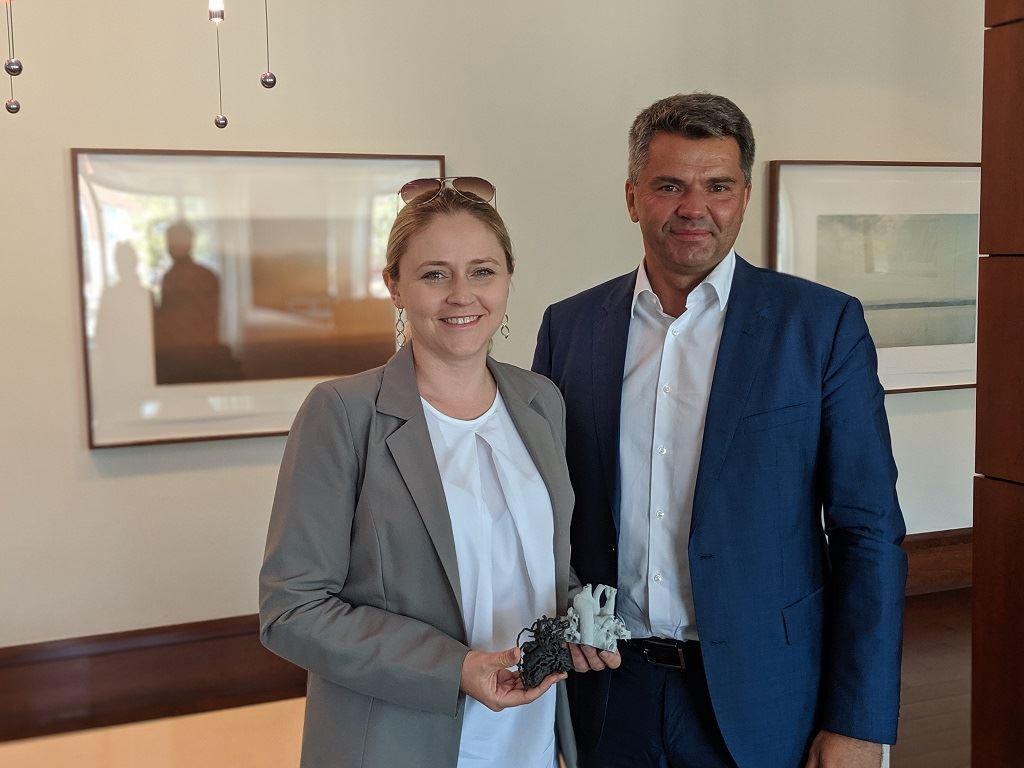![Professor Klaudia Proniewska, PhD, and Professor Dariusz Dudek, MD [Image: Sarah Goehrke]](https://fabbaloo.com/wp-content/uploads/2020/05/jagiellonianuniversity_img_5eb0928eaec68.jpg)
I recently sat down with two experts in cardiology for a conversation about the future of healthcare.
The pair were part of a team visiting the Cleveland Clinic from Kraków, Poland’s Jagiellonian University Medical College: Professor Klaudia Proniewska, PhD, of the Department of Bioinformatics and Telemedicine; and Professor Dariusz Dudek, MD, of the Department of Cardiology, Institute of Cardiology.
3D Printing In Healthcare
We often talk about the rising use of 3D printing in healthcare — naturally, as we’re a 3D printing-focused site.
But we’re always clear that that’s never the whole story; there’s more to everything than 3D printing. In manufacturing, that often means complementary technologies as additive and subtractive manufacturing systems work better side by side. In healthcare, that can mean more advanced solutions including advanced imaging.
Professors Proniewska and Dudek brought with them a couple of 3D printed models of patients’ hearts — and soon turned the discussion away from them.
“With 3D printing, the quality of the printer is getting better and better,” Professor Dudek said. “Diagnostic and imaging needs are still different though, and 3D printing is absolutely needed. In Kraków, there is very much a focus on collaboration as young people are converting echocardiography to 3D to understand it, working with CT and MRI scan data.”
Pointing to the heart models, he noted that a good quality 3D printer is required to get the level of detail and accuracy they had. But ultimately, when it comes to 3D reconstruction of human anatomy, holography offers more versatility and advanced offerings.
Not Only 3D Printing
“Holography” involves the creation of holograms, which are 3D images. In the medical arena, holography can be used in 3D reconstruction, allowing for virtual manipulation of anatomy.
“My feeling is this is much better for the operator,” Professor Dudek said. “You can make smart cuts, take the heart from the body, look at slices of it. But you can’t cut a 3D printed model… With these pictures, you see the inside, you can rotate each part and see the movement. You know where a device is going into a heart and can choose the best one to fit that heart. With a 3D printed model, you can do that — but it takes time and there is limited ability to simulate.”
In the next 3-5 years, he added, more capabilities will be developed to add even more depth to these virtual images.
“The computer will tell you best. This is 3D printing, but not only 3D printing,” he said.
It’s full 3D, in fact. Smartglasses like Microsoft’s HoloLens technology take images seen on computer screens into full 3D view, where the wearer can access different axes of view, rotate the image, adjust the rendering, view different depths, and see into the shadows.
And not just the one viewer: a major advantage of working with virtual imaging is its very virtual nature. When an expert on a particular medical case is able to dial in on a call and put on a HoloLens set, they can provide immediate feedback remotely to a team working directly with a patient.
This has already been observed with 3D printed models, in which the same file can be printed in distanced 3D printing labs and directly compared — but it’s much more immediate with holography. Two or more individuals can be looking at the same design and watch different manipulations, relying less on verbal description and seeing exactly the same image.
Importance Of Holography
Professor Dudek laid out three areas of importance in the rising use of medical holography:
-
Education
-
Simulators
-
Rare cases
The first of these brought the team to the Cleveland Clinic, where they could discuss student learning in the fields of anatomy and physiology.
“We are looking at education in comparison with the anatomy I was learning. These students are now learning anatomy, which is static, and physiology, which is dynamic. The student can see the heart, how it is pumping, with dynamic models. In the very near future, they can learn at the same time for anatomy and physiology. For me, this is how the body functions, and we need to understand both morphology and function. I am 1000% sure it will be good for many students, and this is also where printing in 3D is helpful,” Professor Dudek said.
Much of this training is coming in new ways indeed. One way is the form: not via MDs, but simulators. New methods are bringing in new operators.
The most advanced work the Polish team are currently exploring is in terms of rare cases. While some diagnoses are relatively common and understood, exceptional cases require more study, and this is where holography in particular can be valuable to these medical teams.
“They can use the holographic view in HoloLens to share at the same time in different locations with three or five experts in discussion, working with cross-sections and rotations,” Professor Dudek added. “This is why I think holography is superior to only 3D printing, they can see at the same time what people are discussing. In five years if we’re doing this, I think it will be a very different world of medicine.”
Professor Proniewska added that 3D printing remains the first way forward for education as it stands in 2019, but “the combination is the way of the future.”
3D technologies are having a major impact on both healthcare today and the future of the discipline and standards of care. As these professors pointed out — very correctly, I think — the best way forward is based on collaboration: of teams and, importantly, of technologies.


1 comment
Comments are closed.